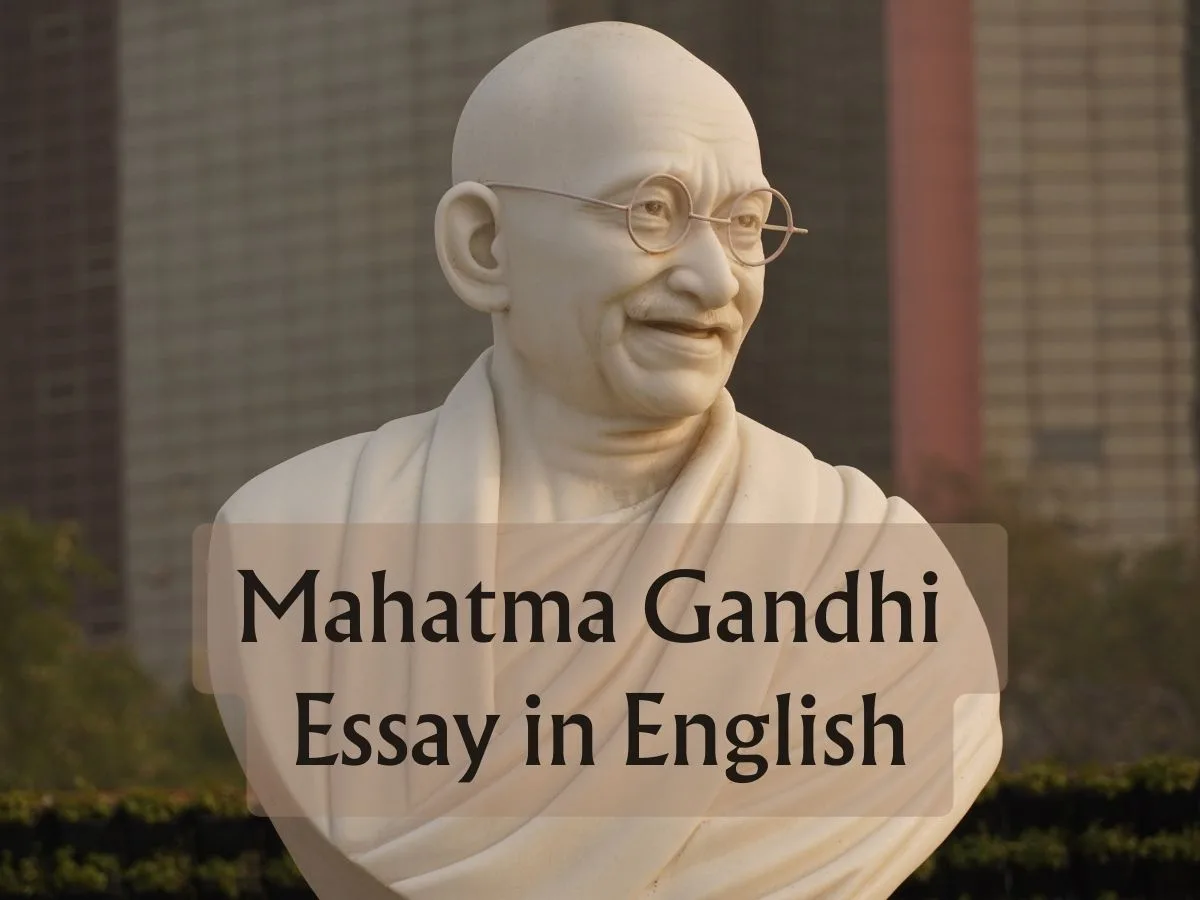Essay on Mahatma Gandhi in English : Explore the remarkable story of Mahatma Gandhi, the father of the Indian independence movement. This detailed essay covers his early life, his pivotal time in South Africa where he developed his philosophy of Satyagraha, and his significant role in India’s fight for freedom. Delve into Gandhi’s personal practices, his campaigns for nonviolent resistance, and his lasting impact on global civil rights movements. Perfect for students, history enthusiasts, and those interested in the power of nonviolence.
Table of Contents
Mahatma Gandhi Essay in English
Mohandas Karamchand Gandhi, popularly known as Mahatma Gandhi or ‘Bapu’. Born on October 2, 1869, in Porbandar, Gujarat, India. Gandhi’s life was marked by his unwavering commitment to truth, nonviolence, and social justice.
His father, Karamchand Gandhi, was the diwan (chief minister) of Porbandar, and his mother, Putlibai, was a deeply religious woman. Gandhi was the youngest of four children.
In 1888, Gandhi traveled to London to study law at University College London. After completing his studies, he returned to India in 1891 and struggled to establish a law practice in Bombay (now Mumbai).
Certainly! Here’s a table summarizing key details about Mahatma Gandhi’s life:
| Attribute | Details |
|---|---|
| Full Name | Mohandas Karamchand Gandhi |
| Birth Date | October 2, 1869 |
| Birth Place | Porbandar, Gujarat, India |
| Father | Karamchand Gandhi |
| Mother | Putlibai Gandhi |
| Spouse | Kasturba Gandhi |
| Children | Harilal, Manilal, Ramdas, Devdas |
| Education | University College London (Law) |
| Key Philosophies | Satyagraha, Nonviolence (Ahimsa) |
| Major Movements | Non-Cooperation, Salt March, Quit India |
| Significant Workplaces | South Africa, India |
| Death Date | January 30, 1948 |
| Cause of Death | Assassination |
| Legacy | Symbol of peace and nonviolence, inspired global civil rights movements |
South Africa and the Birth of Satyagraha
In 1893, Gandhi accepted a one-year contract to work for an Indian firm in Natal, South Africa. This trip proved to be a turning point in his life. In South Africa, he faced racial discrimination firsthand. An incident where he was thrown out of a first-class train compartment despite having a valid ticket left a lasting impact on him.
Gandhi extended his stay in South Africa to fight for the rights of the Indian community. He developed the concept of Satyagraha, meaning “truth-force” or “soul-force,” which advocated for nonviolent resistance against oppression. His efforts led to the eventual success in the struggle for Indian rights in South Africa.
Return to India and Role in Independence Movement
Gandhi returned to India in 1915, where he was warmly received. He joined the Indian National Congress and quickly became a leader in the fight for independence from British rule. Gandhi’s approach was rooted in nonviolence (ahimsa) and Satyagraha. He led several nationwide campaigns, including:
- Non-Cooperation Movement (1920-1922): Gandhi urged Indians to boycott British goods, institutions, and honours.
- Salt March (1930): Also known as the Dandi March, this was a direct action campaign against the British salt tax, involving a 240-mile march to the Arabian Sea, where Gandhi and his followers made their own salt from seawater.
- Quit India Movement (1942): Gandhi called for an immediate end to British rule in India, leading to mass protests and arrests.
Personal Philosophy and Practices
Gandhi’s life was marked by his commitment to simplicity, self-discipline, and nonviolence. He practiced vegetarianism, fasting, and celibacy as part of his spiritual discipline. He also promoted rural development, education, and the upliftment of the untouchables, whom he called Harijans (children of God).
Assassination and Legacy
India gained independence on August 15, 1947. However, the partition of India into India and Pakistan led to widespread communal violence. Gandhi worked tirelessly to promote peace and harmony between Hindus and Muslims.
On January 30, 1948, Gandhi was assassinated in New Delhi by Nathuram Godse, a Hindu nationalist who opposed Gandhi’s efforts to reconcile Hindus and Muslims.
Mahatma Gandhi’s legacy lives on as a symbol of peace, nonviolence, and social justice. His philosophy and methods have inspired civil rights movements around the world, including those led by Martin Luther King Jr. in the United States and Nelson Mandela in South Africa.
Conclusion of Mahatma Gandhi Essay
Mahatma Gandhi’s life was dedicated to the pursuit of truth and nonviolence. His unwavering commitment to these principles not only helped India achieve independence but also left a lasting impact on the global struggle for human rights and justice.
10 lines on Mahatma Gandhi
- Mahatma Gandhi, born on October 2, 1869, in Porbandar, Gujarat, is known as the father of the Indian nation.
- He studied law in London and later moved to South Africa, where he experienced and fought against racial discrimination.
- In South Africa, Gandhi developed his philosophy of Satyagraha, meaning “truth-force” or nonviolent resistance.
- Returning to India in 1915, he became a leading figure in the struggle for independence from British rule.
- Gandhi led several significant movements, including the Non-Cooperation Movement, the Salt March, and the Quit India Movement.
- He promoted nonviolence (ahimsa) and peaceful protest as tools for social and political change.
- Gandhi also advocated for the upliftment of the untouchables, whom he called Harijans, and emphasized rural development.
- His efforts played a crucial role in India’s independence, achieved on August 15, 1947.
- On January 30, 1948, Gandhi was assassinated by Nathuram Godse, a Hindu nationalist opposed to his peace efforts.
- Gandhi’s legacy endures as a global symbol of peace, justice, and nonviolent resistance, inspiring movements worldwide.
Also Read :
Environmental Pollution Essay | It’s Impact | Types
Child Labour essay in English 250 words
FAQ on Mahatma Gandhi
Who was Mahatma Gandhi?
Mahatma Gandhi, born Mohandas Karamchand Gandhi, was a leader of the Indian independence movement against British rule. He is known for his philosophy of nonviolence and peaceful resistance.
When and where was Mahatma Gandhi born?
Gandhi was born on October 2, 1869, in Porbandar, a coastal town in present-day Gujarat, India.
What is Satyagraha?
Satyagraha, meaning “truth-force” or “soul-force,” is Gandhi’s philosophy of nonviolent resistance. It emphasizes truth and nonviolence as powerful tools for social and political change.
What were some key movements led by Gandhi?
Gandhi led several important movements including the Non-Cooperation Movement (1920-1922), the Salt March (1930), and the Quit India Movement (1942).
What impact did Gandhi have on India?
Gandhi’s leadership and nonviolent protests were pivotal in securing India’s independence from British rule in 1947. He also worked towards social reforms, including the upliftment of untouchables and promotion of rural self-reliance.
How did Mahatma Gandhi die?
Gandhi was assassinated on January 30, 1948, by Nathuram Godse, a Hindu nationalist who opposed his efforts to reconcile Hindus and Muslims.
Why is Gandhi called “Mahatma”?
The title “Mahatma” means “Great Soul” in Sanskrit. It was given to Gandhi by the Indian people in recognition of his exceptional leadership and moral integrity.
What is Gandhi’s legacy?
Gandhi’s legacy endures as a global symbol of peace, nonviolence, and social justice. His principles have inspired civil rights movements around the world, including those led by Martin Luther King Jr. and Nelson Mandela.
Did Gandhi receive any international recognition?
Yes, Gandhi was nominated for the Nobel Peace Prize five times, though he never won. He is widely respected and honored globally for his contributions to peace and justice.
What are some famous quotes by Mahatma Gandhi?
1) “Be the change that you wish to see in the world.”
2) “The best way to find yourself is to lose yourself in the service of others.”
3) “An eye for an eye only ends up making the whole world blind.”

